The rose is one of the most beautiful and versatile garden plants, and it comes in many forms, including patio roses, shrub roses, ramblers, and climbers. Almost all of them make excellent cut flowers. In addition, single-flowered roses are excellent pollinator plants, while leafcutter bees use some species as nesting sites. An English garden is incomplete without roses, ideal for creating a romantic, quintessential atmosphere. They are perennially popular because of their classic beauty and heady scent.
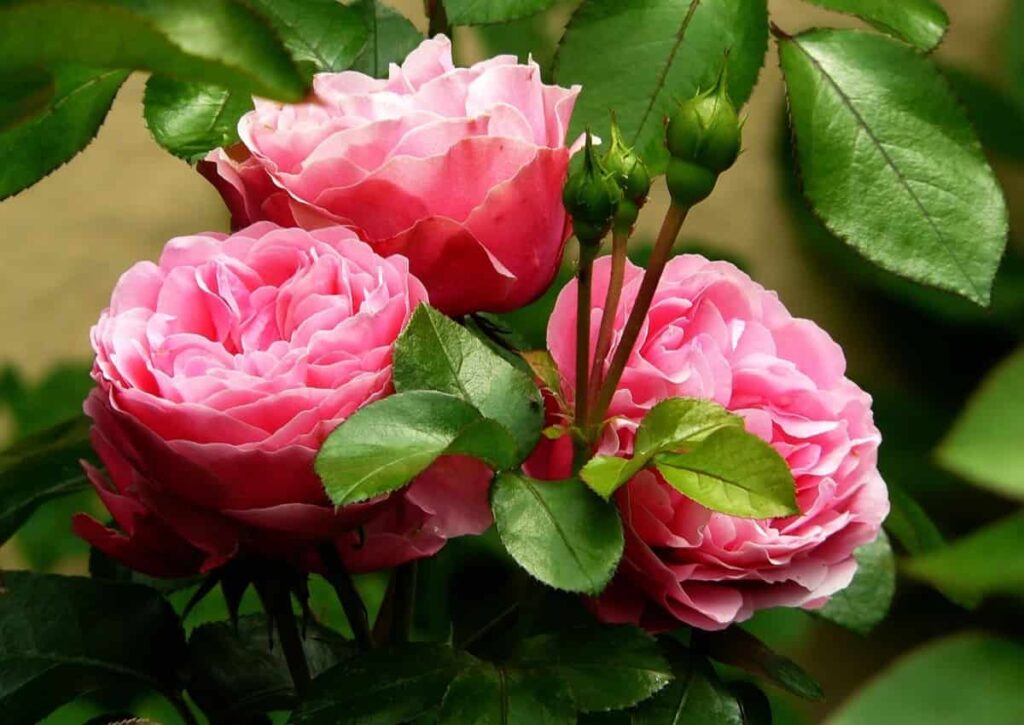
Whether your garden is traditional or contemporary, roses can be incorporated into your planting scheme, whatever its size or style. Various colors, sizes, and growth habits allow roses to blend seamlessly into a cottage garden style, add elegance to formal beds, drape over arches and walls, or be planted in patio containers. The process of starting a rose garden may seem daunting to new gardeners. However, it is unnecessary to be stressed when growing roses for beginners. Most people can successfully grow roses if they properly plant and care for them.
How to make rose plants bushy and flowers bigger
Choosing a planting spot for Rose garden
When it comes to planting roses, you have plenty of options. Make sure they have their spot, start a mini rose garden, or mix them with other plants in your landscape. Roses make excellent additions to edible landscapes where vegetables and other edibles are interspersed with ornamentals. Moreover, they can add colorful fall foliage and flowers.
Good, fertile soil is essential for healthy, productive roses. Almost all well-drained soils will grow roses but incorporate some compost or manure before planting. It might be better to grow them in a raised bed or a large pot, where you can control the soil type and enhance drainage. Make sure your soil is well prepared before planting by blending plenty of manure. For roses to thrive, the soil should have a pH of 6 to 6.5.
Sunlight requirements for a Rose garden
Roses need sunlight and air to grow healthy, glossy leaves and abundant blooms, whether planted in the ground or containers. Make sure you choose a location where you can get as much sun as possible during the day. You should choose spots that offer some protection on hot afternoons if you live in an area where the rays are intense.
When growing roses in hot, humid climates, ensure plenty of breathing room between the plants. Keeping roses healthy and disease-free requires good air circulation. Furthermore, David Austin’s Princess Anne and Phyllis Bide are shade-loving roses. Plant them in partial shade to prevent scorching if you live in a hot or Mediterranean climate.
In case you missed it: How to Grow Potato Plants Faster: Best Tips to Increase Flowering, Fruiting, and Yield
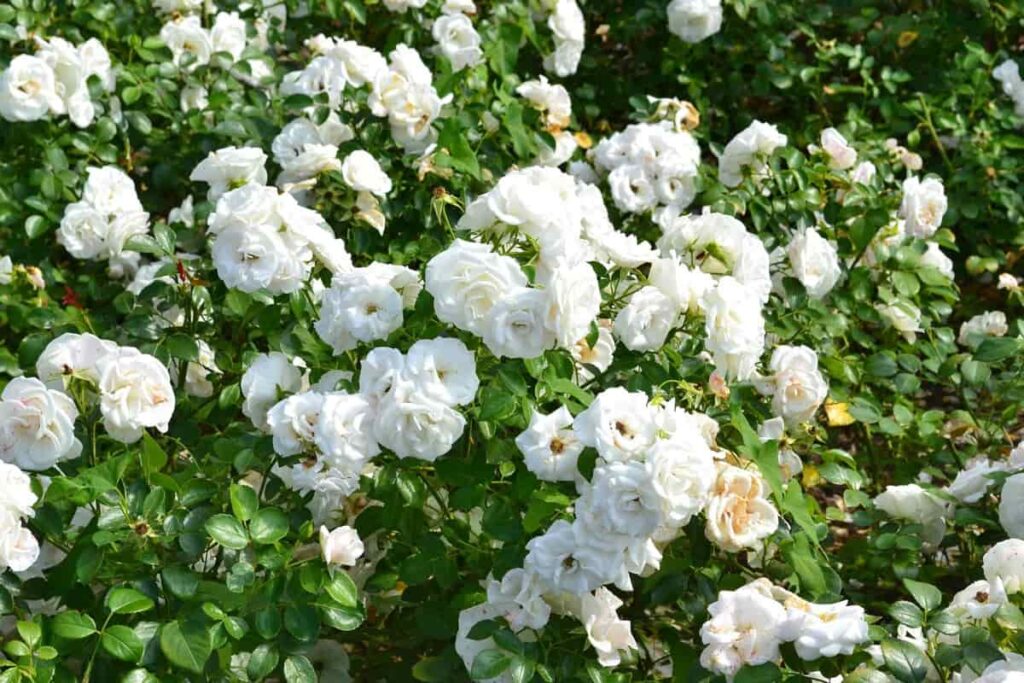
Roses to consider for your Rose garden
Many types of roses are used as flowering shrubs in landscaping. Over 300 species of woody flowering perennials belong to the Rosa genus, and hundreds of types of roses have been cultivated within those species. Unfortunately, even though there are native roses on nearly every continent, most landscape roses are multi-generational hybrid cultivars whose origins are lost to history.
A rose type’s characteristics can only be fully understood by considering the rose class to which it belongs. It is possible to classify roses in a variety of ways. Roses can be classified into different types depending on their color and bloom. Modern roses, old garden roses, and wild roses are considered to be the three types of roses most experts divide into categories.
Hybrid Tea Roses
It features large, ornate blooms with 30 to 50 petals that bloom off long stems, making it one of the most popular rose varieties. Hybrid tea roses have also been bred in thousands, with new varieties constantly replacing obsolete ones. As a result, they are a common type of rose used in landscaping.
Grandiflora Roses
Another of the most popular roses, this class can be considered a subgroup of hybrid tea roses. Typically, this type of rose grows very tall, with clusters of blooms rather than individual blooms.
Shrub Roses
Easily recognizable by their sprawling growth habit, these roses belong to this category. They can reach a height of five to fifteen feet in all directions. Furthermore, they are cold and hardy and produce vigorous flower clusters. Within this group, there are several subcategories. One such category is David Austin English Roses, having recurrent blooms and pleasant fragrances like old garden roses.
Floribunda Roses
It is the second most popular rose type after hybrid teas and Grandifloras. Like Grandiflora roses, floribunda roses bear their flowers in large clusters. It blooms continuously, unlike hybrid teas and Grandiflora roses, which bloom in six- to seven-week cycles. One of the best roses to grow is Floribunda Roses, which requires less maintenance than hybrid teas and Grandifloras.
Climber/rambler Roses:
Last but not least, this category includes roses with long, arching canes that can be trained onto fences, trellises, arbors, and pergolas. They do not belong to a class by themselves. Climbers and ramblers must be tied to their vertical supports to grow upward; they are not clinging or twining plants. It is common for climbers and ramblers to be cold-hardy compared to hybrid roses.
In case you missed it: How to Propagate Peace Lily: Flowering Stages, Planting, Growing, and Care for Indoors and Outdoors
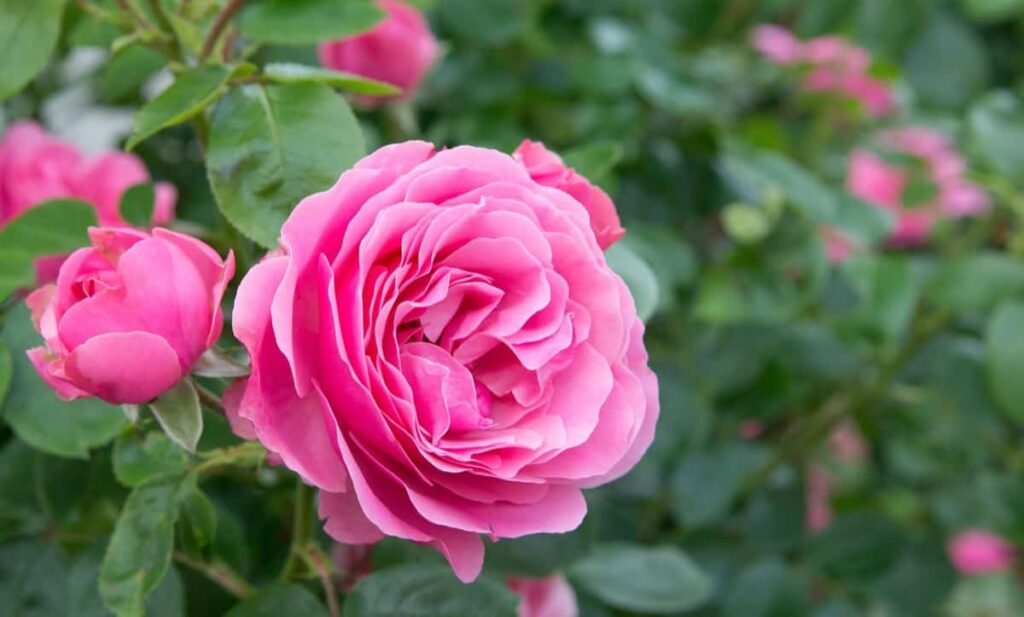
Preparing planting area for Rose garden
It is best to plant garden roses in the ground in late spring, after the first frost, and before the summer heat. A good time to plant is early fall, well before winter threatens. Preparation of the soil should be done in advance if possible. Ideally, roses thrive in slightly acidic soil to near neutral pH, where soil nutrients and fertilizers add extra nutrients that are easily absorbed. Most plants and lawn grasses prefer the same range.
You can learn about the soil and how to improve it for roses by performing a soil test. Test results recommend soil amendments to help improve soil pH outside the optimal range. Then the soil should be fertilized with a complete, balanced fertilizer. It promotes healthy growth, yields more blooms, and provides ongoing nutrition for up to 4 months. Once the soil has been mixed with this plant food, it is ready for roses to be planted.
How to propagate and grow Rose plants from cuttings
Most roses are easy to grow at home, despite their reputation for being finicky. Taking a cutting from the Rose plant will easily reproduce the plant. Rooted cuttings produce replicas of their parents, unlike seeds, which produce very different plants. Reproduction of treasured family heirlooms or favorite garden roses does not require training. When the plants are well-hydrated in the morning, take cuttings from strong, healthy roses. The process of reproducing a new plant from a stem cutting of a Rose plant consists
- A withered bloom should be separated from the woody stem of the rose by a stem or two. It is possible to make several cuttings from one stem.
- The bloom and stem tip should be removed, just above the first set of leaves at the top and again above the last set of leaves at the bottom, cut at a 45-degree angle. Cut stems should be placed in water as soon as possible.
- Ensure that each cutting has four nodes where leaves emerge on stems by cutting each stem into 6 to 8-inch pieces. Moisture should always be kept on cuttings.
- Each cutting should be stripped of all leaves except for one set at the top.1 This ensures the root system of the cutting will be healthy.
- Add a small amount of rooting hormone to the dish. Don’t pour more than you need, and dispose of the excess once you’ve finished.
- Dip the cutting’s bottom half in the rooting hormone until it’s completely covered.
- Prepare your rooting bed or container by digging a hole 3 to 4 inches deep with a stick or pencil. The cutting should be large enough to be inserted without brushing off the hormone.
- The cutting should be inserted into the hole, and the soil around it should be firmed up so that at least two nodes are covered.
In case you missed it: How to Grow Okra Plants Faster: Best Tips to Increase Flowering, Fruiting, and Yield
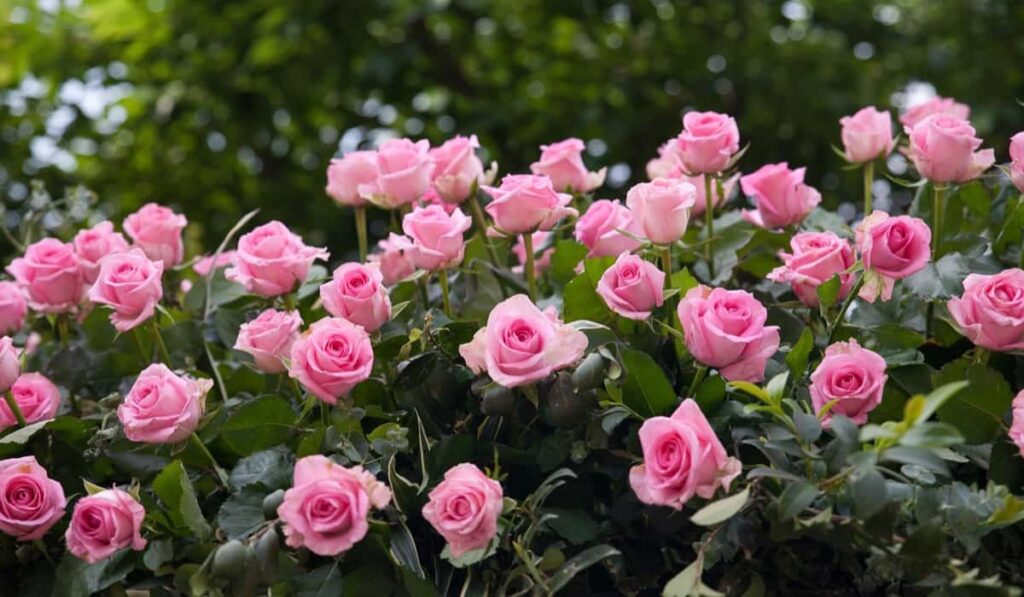
Rose garden care
How and when to water your Rose plants
Roses must be watered diligently during and after planting during the summer months. The watering of roses is not complicated, but it is essential for fresh, plump rose petals and thick, strong stems. To grow strong roots to withstand hot temperatures and drought, water roses deep and thoroughly once or twice a week to saturate the root zone. Be sure to water the soil frequently enough to keep it moist, but don’t let it become too wet. It is just as important to provide air to rose roots as it is to provide air to rose leaves.
Rose plants benefit from a layer of organic mulch around their roots to retain soil moisture and prevent dirt from splashing on their blooms. When the weather cools in early to mid-fall, reduce watering but do not allow the soil to dry out completely. The roses should be watered at the soil level early in the morning so that leaves and stems stay dry. The spread of many rose diseases is dependent on water droplets. Therefore, it is recommended that you water your plants early in the morning so that the sun and wind will dry the wet leaves quickly.
How and when to fertilize your Rose plants
It is more abundant when the roses are well-fed to produce big, luxurious blooms and simple, five-petaled flowers. Planting roses in good soil with organic matter upfront will help them make the most of the soil, but they will also benefit from additional nutrients as they grow. A fertilizer that provides roses with a special blend of nutrients should be applied regularly throughout the growing season.
Pull away any mounds of compost or mulch from the base of each bush as soon as the first leaf buds form in early spring. Next, feed each plant a “rose smoothie” consisting of a quarter cup of Epsom salts mixed with organic rose fertilizer.
Mulching for Rose plants
Mulching is highly recommended for all roses, even those planted in pots. As an insulator, mulch protects the soil from temperature variations and helps retain moisture. Therefore, you will need to water and weed your garden less often. In addition, adding mulch to your roses will give them the nutrients they need as the matter breaks down.
The best period to apply mulch is during the winter and early spring when the soil is still moist from the winter rains. A thick layer of mulch, approximately 3 to 5 cm thick, should be applied. The mulch will soak up water before it reaches the soil, preventing water from reaching it. Avoid collar rot by keeping the mulch at least 2 to 3 cm away from the stem base.
When and how to prune your Rose plants
It is typical for mature rose plants to be pruned hardy in mid-January and prepared for dormancy. Even seasoned rosarians have different approaches to pruning. Every plant should be pruned back by roughly 50%, ensuring that the cuts are about half an inch above an outward-facing leaf bud. All crisscrossing branches, branches smaller than a pencil thickness, and dead wood that occurred during the blooming season should be stripped and flushed.
In case you missed it: How to Grow Peas Faster: Best Tips to Increase Flowering, Fruiting, and Production Yield
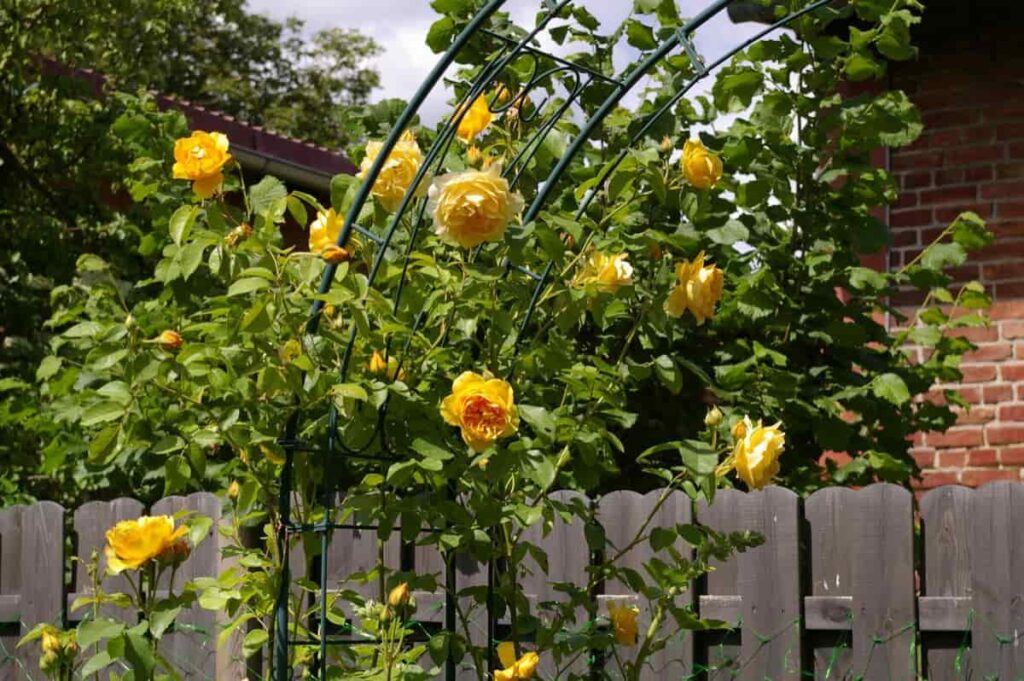
Keep the base of roses free from debris and fallen leaves to prevent the harboring of disease and insects and to ensure ample airflow. As early as April and as late as December, most modern roses will bloom a minimum of three times. Whenever new buds form, finger-prune them, aiming toward the center of the plant, where two or three may grow from the same spot.
It is recommended to deadhead the plant judiciously in the spring and summer once it begins blooming. New, healthy blooms can be produced by pruning old blooms just above a leaflet with five or seven leaves. The stems should be cut back to a pencil width if they are thinner than a pencil.
Pests and diseases affecting your Rose garden
Black Spot
Black spots are one of the most common diseases of roses. In addition, infected roses are susceptible to other environmental pressures due to black spots caused by the fungus Diplocarpon rosae. This fungal issue is the most common during spring and fall when conditions are wet and cool nights prevent moisture from evaporating. Often, black spot disease begins at the base of the plant and progresses upwards.
Several types of sprays can be used to treat black spot disease. Once an infection sets in, this is a very difficult disease to treat, so early treatment is essential. Spray the plants with about a teaspoon of baking soda mixed with a quart of warm water, or use sulfur- or copper-based fungicidal sprays.
Botrytis Blight
A hot and humid summer is the perfect breeding ground for this fungal infection, caused largely by environmental factors. Botrytis blight can be temporarily controlled with fungicides, but it often develops a resistance to these sprays, making them ineffective after prolonged use. Sunlight and dry weather, however, are often enough to control the condition.
Cankers
A fungus infection like this can be ugly and potentially fatal. Whenever the plant has been recently pruned, canker reveals itself by turning the canes black. It is always a good thought to clean your pruners between plantings to prevent this from happening. During the year’s colder months, cankers often cause the most trouble, making them harder to detect than other diseases. There are three types of canker that affect roses:
- Brown Canker
- Brand Canker
- Stem Canker
Remove infected tissue and canes with clean, sharp pruners. Follow up with a fungicidal treatment to give your roses an extra boost against reinfection by cutting into healthy, green areas. Every time you cut, make sure you sanitize your tools. In addition, plants can be prevented by mulching their roots and fertilizing them adequately to prevent too much cold in the winter.
How to make Roses bigger and bushy
Maintain an appropriate watering schedule
Keep the soil moist but not saturated when watering the rose bush. One week of watering may be necessary during the hot summer months.
Fertilize with a balanced fertilizer
Balanced fertilizers, such as 10-10-10, provide nitrogen for healthy foliage, phosphorus for strong roots, and potassium for blossom production. The plant should receive its first fertilizer application in the spring after emerging from dormancy. It will take two more applications in mid-June and mid-July for the flower show to continue. Finally, allow the plant to prepare for winter dormancy by stopping fertilizing in August.
In case you missed it: How to Grow Cucumber Plants Faster: Best Tips to Increase Flowering, Fruiting, and Production Yield

Remove crossing or poorly formed stems
Remove any stems growing toward the middle, downward, or crossing over another stem that appears to be growing toward the middle. Stems should only be kept if they are strong.
At bud, fertilize Again with a high Phosphorus mix
You can promote flower growth by fertilizing the stem with an 8-10-8 formula. Fertilizer should be applied at the rate recommended on the package. Roses should be fertilized when their stems are long, but their buds have not yet opened. During this time, discourage more foliage growth and encourage the rose bush to devote all its energy to blooming, so use a 0-50-30 fertilizer at half the recommended rate.
Prune back hard in early spring
Pruning the rose bush in January encourages sturdy canes to support the large blooms; Heirloom Roses are recommended. The bush should be cut between 18 and 24 inches tall in spring. Cutting the bush back will result in fewer blooms, but the blooms will be larger. All dead and damaged canes and those pointing toward the bush’s interior should be removed at that time.
Deadhead Spent Blooms
When the blooms on the rose bush have faded, deadhead it. Dead roses should be cut back to the first mature leaf cluster with five leaves. Follow the stem back until it becomes thicker when growing large roses.
Conclusion
Buying a rose often looks nothing like the gorgeous plant you imagine growing in your garden. But, despite their appearance, these roses are not fragile. Prepare the rose’s future home with a little extra effort at planting time; you will have healthier plants and more blooms. Don’t have to be intimidated by starting a rose garden or knowing how to take care of roses. You might think it’s not easy, but it’s not. Providing them with what they need will reward you with beautiful blooms before you know it.
- Budget Friendly Sheep Shed Ideas: Cheap and Low-Cost Tips
- How Much Do Cattle Farmers Make: Revenue Streams in Cattle Farming
- Management Pests and Diseases in Your Cotton Field
- Sheep Farming Business Plan for Beginners
- Aquaponic Farming at Home: A Step-By-Step Guide
- Profitable Village Farming Business Ideas in 2024
- High-Yield Aquaculture: Fast-Growing Fish for Farming
- Effective Fish Pond Construction Techniques for Beginners
- Irrigation and Water Management in Pineapple Farming
- Blossom to Harvest: Mastering Flowering and Pollination in Papaya Farming
- Pig Fattening Essentials: From Selection to Sale for Beginners
- Raising Wagyu Cattle: A Complete Guide for Premium Beef Production
- Soil Types and Their Water Holding Capacity
- Optimizing Irrigation Schedules for Coconut Groves for Enhanced Yield
- Espresso Your Garden: Coffee Grounds for Healthier Acid-Loving Plants
- The Best Soil Mix for Snake Plants: How to Mix Your Own Snake Plant Soil
- Green Thumb Success: Expert Tips for Cultivating Greenhouse Beans All Year Round
- Bloom All Year Round: The Ultimate Guide to Indoor Hyacinth Care
- Eco-Friendly Gardening: How to Make Liquid Fertilizer from Kitchen Waste
- Ultimate Guide to Grow Anise in Pots: Explore Seed Propagation to Harvesting
- Guide to Raising Chester White Pigs: Discover Breed Facts to Growth Management
- Mastering the Elegance: The Ultimate Guide to Weeping Cherry Tree Care, Planting, and Maintenance
- Ultimate Guide to Planting Garlic in Grow Bags: Growing Strategies for Beginners
- How to Fix Spider Plant Leaf-Related Problems: Natural and Organic Remedies
- 10 Reasons Why Your Tulsi Plant is Shedding Leaves: Home Remedies and Solutions
- Optimizing Growth and Yield: The Advantages of Palm Bunch Ash Fertilizer
- Utilizing Neem Oil Extract as a Natural Pesticide for Hydrangea
- From Soil to Harvest: Various Ways in Which Farmers Can Use AI Tools
- Steps to Encourage and Induce Citrus Flowers: A Comprehensive Guide
- How to Fix Snake Plant Leaf-Related Issues: Natural and Organic Remedies
- Transform Your Garden into a Fragrant Oasis with Raat Ki Rani (Night Blooming Jasmine)
- Discover the Ideal Chicken Breeds for Philippine Farms
- How to Create a Poultry Egg Farm Business Plan for Profits
- Grow Lemon Cucumbers Like a Pro: Insider Techniques for Bountiful Yields
- Ultimate Guide to Caring for Your Pink Princess Philodendron: Tips for Thriving Variegation
- Areca Nut Profit Per Acre: Calculating Yield and Cost of Cultivation
